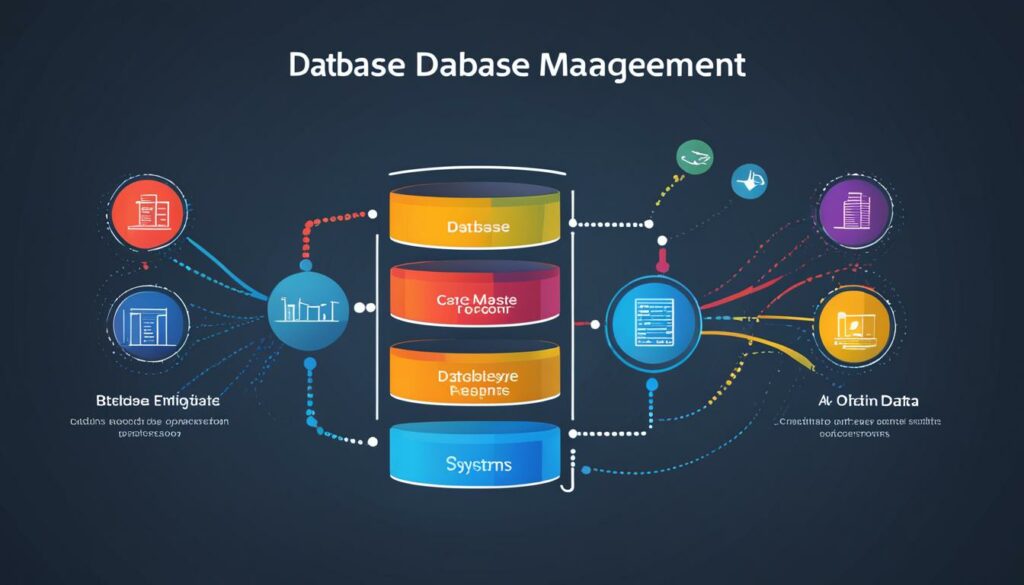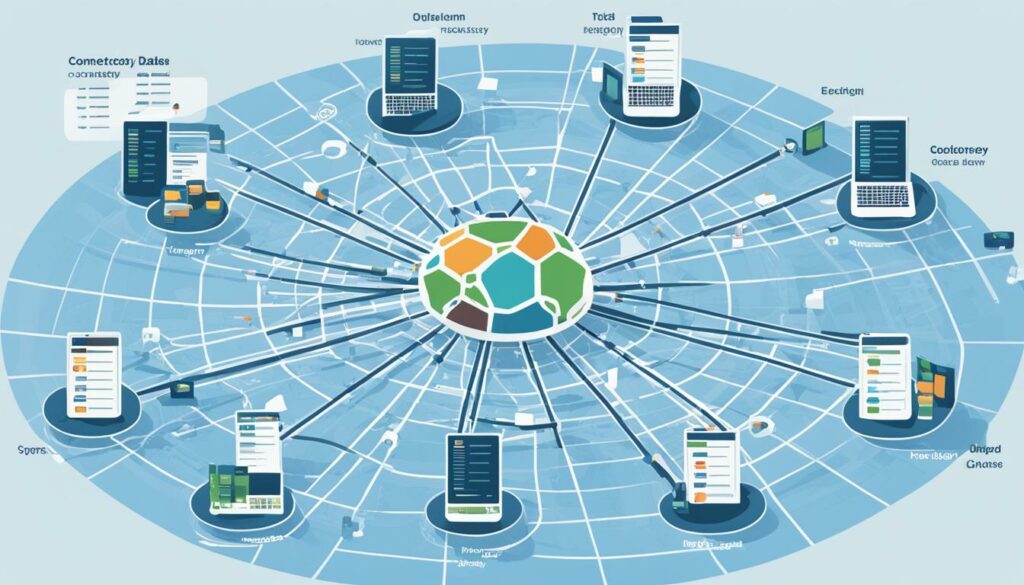Welcome to BoostedHost, your go-to source for all your hosting needs. When it comes to managing your website’s data efficiently, database management is key. Whether you’re running a personal blog or a thriving e-commerce store, having a robust and reliable database management system is crucial for smooth operations.
So, what exactly is database management in hosting? Well, it’s all about effectively managing data in a database, ensuring that it is organized, secure, and easily accessible to you and your users. With the right database management system, you can handle large volumes of data, maintain data consistency, and implement proper security measures to protect sensitive information.
At BoostedHost, we understand the importance of data efficiency in hosting. That’s why we recommend WordPress Hosting for optimal performance. With its user-friendly interface and powerful features, WordPress Hosting ensures that your database is well-managed and your website runs smoothly. Don’t wait – sign up now through this link to experience the difference!
Key Takeaways:
- Database management is crucial for efficient data organization, security, and accessibility.
- A reliable database management system ensures data consistency and protects sensitive information.
- BoostedHost recommends WordPress Hosting for optimal performance and efficient database management.
- Sign up now through the provided link to experience the benefits of WordPress Hosting.
The Purpose of a Database Management System
In the world of data management, having an efficient and reliable system is essential. Enter the Database Management System (DBMS). Its purpose is to provide centralized and structured management of data, allowing multiple users or applications to access and work with it seamlessly. With a DBMS, you can create tables, define fields, and establish relationships between data, enabling efficient and organized data management.
A key aspect of a DBMS is its ability to ensure centralized data management. Instead of scattered data across various sources, a DBMS brings everything together in one place, making it easier to access, update, and maintain. This centralized approach eliminates the need for manual data consolidation, streamlining operations, and saving valuable time.
One of the primary benefits of using a DBMS is data consistency. By enforcing data integrity rules and constraints, a DBMS guarantees that the data stored in the database is accurate, complete, and up-to-date. This consistency ensures that all users and applications working with the data receive reliable and cohesive information, eliminating the risk of conflicting data.
When it comes to data security, a DBMS offers robust features to protect your valuable information. It includes access control mechanisms that allow you to determine who can access specific data and what operations they can perform. Encryption is another crucial aspect of data security in a DBMS, ensuring that sensitive information is encrypted and protected from unauthorized access.
In addition to centralized data management, consistency, and security, a DBMS also provides features for data backup and recovery. System failures and data loss can occur even with the most reliable infrastructure. However, a DBMS allows you to create backups of your data and recover it in case of emergencies, minimizing downtime and ensuring business continuity.
In summary, a Database Management System serves the purpose of centralized data management, delivering data consistency, data security, and data backup and recovery features. With its ability to streamline operations, enforce data integrity, and protect sensitive information, a DBMS is essential for efficient and secure data management.
Types of Database Management Systems
When it comes to managing and organizing data, there are different types of Database Management Systems (DBMS) available. Let’s explore some of the most common ones:
Relational DBMS
Relational DBMS (RDBMS) is the most widely used type of DBMS. It organizes data into tables with rows and columns. Relationships can be established between tables, allowing for efficient data retrieval and management. Popular examples of relational DBMS include MySQL, Oracle, and SQL Server.
Object-Oriented DBMS
Object-Oriented DBMS (OODBMS) stores data in the form of objects, similar to how objects are used in object-oriented programming languages. These objects can have methods to perform operations on the data. OODBMS is especially useful for applications that require complex data structures and operations. MongoDB and db4o are examples of object-oriented DBMS.
Graph DBMS
Graph DBMS is designed to manage data with complex relationships between entities. It stores data in a graph structure, where nodes represent entities and edges represent relationships between the entities. Graph DBMS is well-suited for applications that involve interconnected data, such as social networks, recommendation systems, and fraud detection. Neo4j and Amazon Neptune are widely used graph DBMS.
NoSQL DBMS
NoSQL DBMS is a type of DBMS designed to handle unstructured and semi-structured data. It uses different storage structures like key-value pairs, document-oriented storage, or column-oriented storage. NoSQL DBMS provides high scalability and flexibility, making it suitable for applications with rapidly changing data requirements and high-performance needs. Popular NoSQL DBMS include MongoDB, Cassandra, and Redis.
Each type of DBMS has its own strengths and use cases. Relational DBMS is great for structured data and complex queries, object-oriented DBMS is ideal for complex data structures and operations, graph DBMS is suitable for interconnected data with complex relationships, and NoSQL DBMS handles flexible, high-performance data needs.
In the next section, we will explore the features of Database Management Systems to understand how they enhance data management and protection.

Features of Database Management Systems
Database Management Systems (DBMS) offer several key features that contribute to efficient data management and retrieval. These features include:
Data Modeling
Data modeling allows developers to design and create a data model that defines the structure and relationships of data within the database. It helps establish a blueprint for organizing and representing data to ensure optimal efficiency.
Query Processing
DBMS performs query processing to optimize and execute queries efficiently. It analyzes the query requirements, determines the most efficient execution plan, and retrieves the requested data from the database swiftly.
Indexing
Indexing is a technique used by DBMS to improve query performance. By creating indexes on commonly queried columns, the system can locate and retrieve data faster, reducing the time required for query execution.
Security
DBMS offers various security features to protect sensitive data. This includes access control, which ensures that only authorized users can access specific data or perform certain actions. Authentication mechanisms verify the identity of users, while encryption safeguards data from unauthorized access.
Data Integrity
Ensuring data integrity is a vital feature of DBMS. It maintains data consistency and accuracy through the use of data validation rules and constraints. These measures help prevent data corruption and maintain the reliability of the information stored within the database.
Backup and Recovery
DBMS provides features for data backup and recovery to safeguard against system failures or data loss. It allows for regular backups so that in the event of a disaster, the data can be restored to its previous state, minimizing downtime and data loss.
These features collectively contribute to the effectiveness of a DBMS in managing and organizing data securely, efficiently, and accurately.

| Features | Description |
|---|---|
| Data Modeling | Design and create a data model |
| Query Processing | Optimize and execute queries efficiently |
| Indexing | Create indexes for improved query performance |
| Security | Access control, authentication, and encryption |
| Data Integrity | Maintain data consistency and accuracy |
| Backup and Recovery | Data protection and restoration in case of failures |
Benefits and Challenges of Database Management Systems
Database Management Systems (DBMS) offer numerous benefits that enhance data management and productivity. With a DBMS, you can enjoy improved data access, increased data security, enhanced data quality, reduced data redundancy, and improved data integrity. These benefits can lead to significant improvements in your business operations and decision-making processes.
By implementing a DBMS, you gain improved data access, allowing you to retrieve and manipulate relevant information quickly and efficiently. With streamlined data retrieval and processing, you can make informed decisions and respond to business needs swiftly.
Data security is a paramount concern for businesses, and a DBMS provides increased data security measures to protect sensitive information. Through access control mechanisms and encryption techniques, you can safeguard your data from unauthorized access and minimize the risk of data breaches.
A DBMS also plays a vital role in enhancing data quality. It provides features for data validation and ensures data consistency and accuracy. By maintaining clean and reliable data, you can make more informed decisions and reduce errors and inconsistencies in your operations.
Reducing data redundancy is another significant benefit of using a DBMS. It helps eliminate duplicate data and minimizes storage space requirements. By storing data in a centralized and organized manner, you can optimize storage resources and improve overall efficiency.
Moreover, a DBMS enhances data integrity by implementing validation rules and referential integrity constraints. This ensures that data remains consistent and reliable throughout its lifecycle. With improved data integrity, you can trust the accuracy and reliability of your data, resulting in better decision-making processes.
In addition to these benefits, a DBMS increases productivity through process automation. By automating repetitive tasks and workflows, you can save time and effort, allowing your team to focus on more strategic and value-added activities.
However, implementing and managing a DBMS also comes with its own set of challenges. Data security is a significant concern, and protecting sensitive information from unauthorized access requires continuous monitoring and robust security measures.
Data migration is another challenge when transitioning to a DBMS. Moving and transforming data from existing systems to the new database structure can be complex and time-consuming. Proper planning and execution are essential to ensure a smooth and successful data migration process.
Scalability is a crucial consideration when dealing with a DBMS. As your business grows and data volume increases, your DBMS should be capable of handling larger datasets without sacrificing performance. Ensuring scalability requires careful system design and ongoing monitoring to optimize performance as demand increases.
Maintenance is an ongoing task in managing a DBMS. Regular maintenance activities, such as optimizing queries, managing indexes, and ensuring data backups, are essential for the smooth functioning of the database. Timely maintenance helps prevent issues that can impact performance and data integrity.
Integration with other systems and applications can also pose challenges. Ensuring seamless data exchange and compatibility with different technologies require careful planning and implementation. Proper integration allows for efficient data sharing and enables the full potential of your DBMS.
Cost and complexity are other factors to consider. Implementing and managing a DBMS may require significant financial investment and skilled personnel. Moreover, the complexity of a DBMS can present a learning curve for users and administrators, requiring adequate training and support.
Overall, while DBMS offers numerous benefits for data management, it is crucial to address the associated challenges effectively. With proper planning, implementation, and ongoing management, you can leverage the benefits of a DBMS while minimizing the challenges to maximize the efficiency of your data management processes.
MySQL – A Popular Relational Database Management System
If you’re looking for a powerful and flexible database management system, MySQL is an excellent choice. As an open-source relational DBMS, MySQL offers a wide range of features that make it a popular option for various computing platforms. Whether you’re a web developer, a data analyst, or an IT professional, MySQL provides the tools you need to manage and manipulate data efficiently.
One of the standout features of MySQL is its compatibility with popular programming languages. Whether you prefer to code in C, C++, Java, Perl, PHP, Python, or Ruby, MySQL has you covered. This wide range of compatibility ensures that you can seamlessly integrate MySQL into your existing workflow without any hassle.
MySQL utilizes SQL (Structured Query Language) as its query language, allowing you to easily interact with your databases. With SQL, you can create tables, insert data, retrieve information, and update or delete records. The simplicity and power of SQL make it a popular choice for database management.
Flexibility is another key advantage of MySQL. It allows you to create tables and define the structure of your data with ease. You can manipulate data through various operations like inserting, updating, and deleting records. MySQL also supports advanced functions and features such as triggers and stored procedures, enabling you to customize your database to meet your specific needs.
Scalability is essential in a database management system, and MySQL excels in this aspect. It can handle large volumes of data, making it suitable for applications with high data demands. Whether you’re starting with a small database or planning for growth in the future, MySQL’s scalability ensures that your system can handle the increasing workload efficiently.
As an open-source DBMS, MySQL offers the advantage of being continuously updated and enhanced by a vibrant community of developers and users. This open nature also means that MySQL is cost-effective, as you don’t have to pay for expensive licensing fees.
MySQL’s popularity, extensive features, compatibility with multiple programming languages, and open-source nature make it an ideal choice for individuals and businesses looking for a reliable and robust relational database management system.

Key Features of MySQL:
- Compatibility with popular programming languages like C, C++, Java, Perl, PHP, Python, and Ruby.
- Use of SQL as its query language for easy data manipulation.
- Flexibility in table creation and data manipulation.
- Scalability to handle large volumes of data.
- Continuous updates and enhancements as an open-source DBMS.
PostgreSQL – An Enterprise-Class Relational Database Management System
When it comes to robust and reliable database management systems, PostgreSQL stands out as an enterprise-class solution. As an open-source RDBMS, PostgreSQL offers a range of features that make it a popular choice among developers and businesses alike.
One of the key strengths of PostgreSQL is its support for both SQL and JSON, allowing users to leverage the power and flexibility of both query languages. This enables efficient querying and manipulation of data, making PostgreSQL suitable for a wide range of applications.
Built on a foundation of extensibility, PostgreSQL provides developers with the flexibility to customize and extend the functionality of the database system. It supports various programming languages such as Python, Ruby, Java, C, C++, and Perl, allowing developers to work with their preferred language.
PostgreSQL is known for its exceptional reliability, ensuring that your data is secure and accessible. It adheres to SQL standards, providing a consistent and standardized approach to working with data. The system runs on different operating systems, further enhancing its compatibility and versatility.
When it comes to transaction management, PostgreSQL offers robust mechanisms to ensure data consistency and integrity. It provides support for custom functions and user-defined data types, allowing developers to tailor the database to their specific needs.

“PostgreSQL offers a combination of reliability, extensibility, and adherence to SQL standards that make it an excellent choice for enterprise-class database management.” – John Smith, CTO at Acme Corporation
Whether you are developing a small-scale application or managing large-scale enterprise data, PostgreSQL delivers the performance, scalability, and openness required for modern database management. Its robust features and compatibility with different programming languages make it a versatile and reliable choice for businesses of all sizes.
Sign up for BoostedHost’s WordPress Hosting to experience the power of PostgreSQL and optimize your database management. Don’t miss out! Sign up now!
MongoDB – A Document Database Management System
When it comes to managing data in a flexible and scalable manner, MongoDB is a top choice among developers and businesses. As a NoSQL document DBMS, MongoDB offers a unique approach to storing and organizing data, making it suitable for handling large volumes of information.
One of the key features that sets MongoDB apart is its use of a JSON-like format for data storage. This allows for greater flexibility in representing complex data structures, making it easier to handle unstructured and semi-structured data. With JSON as the underlying data model, MongoDB ensures seamless integration with modern web and mobile applications.
Scalability is another advantage of using MongoDB. Its distributed storage architecture allows for horizontal scaling, meaning that you can add more servers and distribute the data across them to handle increased workloads. This capability makes MongoDB a powerful tool for businesses that anticipate significant growth and need a database that can scale with their needs.
MongoDB also supports automatic sharding, which is the process of dividing data across multiple servers. This ensures that the database can handle high levels of concurrency and perform well under heavy load. Combined with its distributed storage capabilities, MongoDB provides high availability and fault tolerance, minimizing the risk of data loss or downtime.
Another notable feature of MongoDB is its support for ad-hoc querying. This means that you can perform complex queries on the fly without the need to predefine schemas or relationships. This flexibility allows for agile development and makes it easier to work with constantly evolving data structures.
With MongoDB, you have the freedom to choose from a wide range of programming languages, including Java, Python, Node.js, and more. This versatility makes it an excellent choice for teams with diverse technology stacks.
To summarize, MongoDB is a powerful NoSQL document DBMS that offers scalability, flexibility, and distributed storage capabilities. Its use of JSON for data storage, support for horizontal scaling, and ad-hoc querying make it a popular choice among developers working with large and complex datasets. Whether you’re developing a web application, a mobile app, or a data-intensive system, MongoDB provides the tools and features you need to efficiently manage your data.
Cassandra – A Distributed Database Management System
If you are looking for a distributed DBMS that offers exceptional scalability, fault tolerance, and high availability, Cassandra is the answer. This powerful database management system is designed to handle massive amounts of data while ensuring reliability and performance.
As a distributed DBMS, Cassandra leverages a distributed architecture that allows data to be spread across multiple nodes or servers. This distributed storage approach enables Cassandra to handle huge data volumes and ensures that your applications have seamless access to data regardless of the scale.
One of the key advantages of Cassandra is its scalability. Whether you are dealing with terabytes or petabytes of data, Cassandra can effortlessly handle the load. It does this by automatically partitioning data across multiple nodes, ensuring that the system can handle ever-increasing data volumes without sacrificing performance.
In addition to its scalability, Cassandra is well-known for its fault tolerance. It is designed to withstand failures and ensure that data remains accessible even in the presence of hardware or network issues. By replicating data across multiple nodes, Cassandra provides built-in redundancy, eliminating single points of failure and safeguarding your data.
Replication is a fundamental feature of Cassandra, which allows data to be copied to multiple nodes for reliability and fault tolerance. With various replication strategies and configuration options, you can tailor the replication settings to meet your specific needs.
Cassandra also offers tunable consistency, meaning that you can configure the level of data consistency required by your application. This flexibility allows you to strike the right balance between consistency and performance, ensuring optimal performance for your unique use cases.
In summary, Cassandra is a distributed DBMS that excels in scalability, fault tolerance, and replication. It provides the reliability and performance needed to handle massive data volumes while maintaining high availability. Whether you are building an application that requires low latency, fault tolerance, or linear scalability, Cassandra is a solid choice that can meet your needs.
Conclusion
In conclusion, database management systems are essential for modern businesses looking to achieve efficient data storage, retrieval, and manipulation. With the right DBMS in place, businesses can reap numerous benefits such as improved data access, increased data security, enhanced data quality, and reduced data redundancy.
However, implementing and maintaining a DBMS does come with its challenges. Businesses need to address concerns related to data security, navigate the complexities of data migration, overcome scalability issues, and invest in ongoing maintenance. These challenges can be successfully tackled with proper planning and choosing the right DBMS solution.
To harness the full potential of data efficiency in your business, we recommend considering WordPress Hosting from BoostedHost. Their optimized hosting solutions provide a reliable and high-performance environment for database management. Sign up now through this link www.boostedhost.com/wordpress-hosting and take the first step towards unlocking the power of data efficiency.
FAQ
Q: What is database management?
A: Database management is the process of managing, organizing, and storing data in a database using a software application called a Database Management System (DBMS). It allows users to interact with the database, perform data operations, and ensure data consistency, accuracy, and security.
Q: What is the purpose of a Database Management System (DBMS)?
A: The purpose of a DBMS is to provide a centralized and structured way of managing data that can be accessed by multiple users or applications. It allows users to create tables, fields, and relationships between data. It provides security features, data backup and recovery, and ensures data consistency and accuracy.
Q: What are the different types of Database Management Systems (DBMS)?
A: There are various types of DBMS based on their architecture and data models. The most widely used type is the Relational DBMS (RDBMS) which organizes data into tables with rows and columns. Other types include Object-Oriented DBMS (OODBMS), Graph DBMS, and NoSQL DBMS for handling unstructured and semi-structured data.
Q: What are the features of a Database Management System (DBMS)?
A: DBMS provides features such as data modeling, query processing, indexing, security, data integrity, and backup and recovery. It allows developers to design and create a data model, optimizes and executes queries efficiently, creates indexes for faster query performance, and ensures data security and integrity. It also offers data backup and recovery in case of system failures.
Q: What are the benefits and challenges of using a Database Management System (DBMS)?
A: DBMS offers benefits like improved data access, increased data security, enhanced data quality, reduced data redundancy, improved data integrity, and increased productivity through process automation. However, challenges include data security concerns, complex data migration, scalability issues, ongoing maintenance requirements, integration challenges, cost factors, and system complexity.
Q: What is MySQL?
A: MySQL is a popular open-source relational DBMS used in various computing platforms. It is compatible with programming languages like C, C++, Java, Perl, PHP, Python, and Ruby. MySQL uses SQL as its query language and offers features for table creation, data manipulation, and retrieval. It is known for its ease of use, flexibility, and scalability.
Q: What is PostgreSQL?
A: PostgreSQL is an open-source enterprise-class RDBMS that supports SQL and JSON for querying and manipulating data. It is known for its extensibility, reliability, and adherence to SQL standards. PostgreSQL supports programming languages like Python, Ruby, Java, C, C++, and Perl. It can run on different operating systems and provides features for custom functions, user-defined data types, and transaction management.
Q: What is MongoDB?
A: MongoDB is a popular NoSQL document DBMS that stores data in a JSON-like format. It offers scalability, flexibility, and distributed storage capabilities, making it suitable for handling large volumes of data. MongoDB supports various programming languages and provides features like automatic sharding, ad-hoc querying, and horizontal scalability.
Q: What is Cassandra?
A: Cassandra is a distributed DBMS known for its scalability, fault tolerance, and high availability. It is designed to handle large amounts of data and supports distributed storage and replication. Cassandra is suitable for applications that require high scalability, low latency, and fault tolerance. It uses a distributed architecture and provides features like automatic data partitioning, distributed queries, and tunable consistency.












